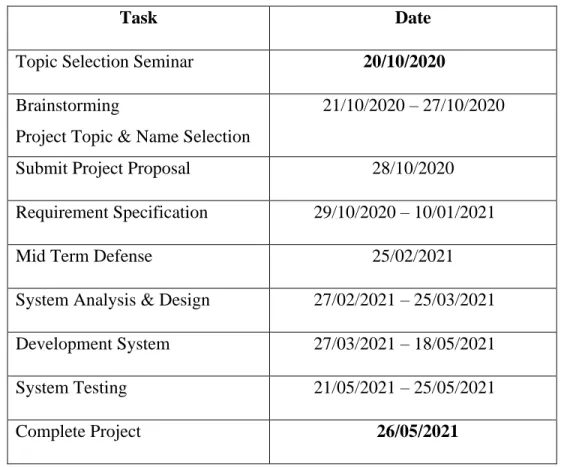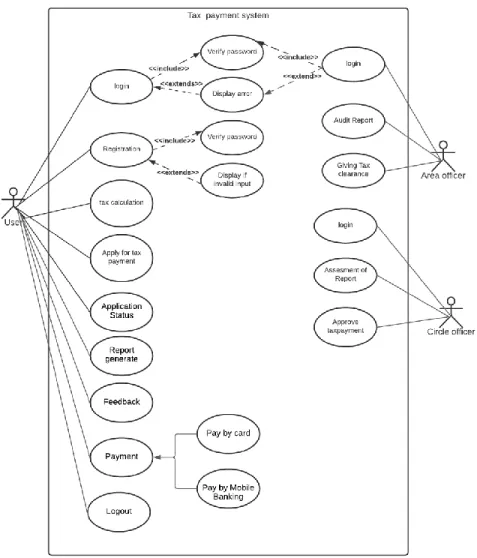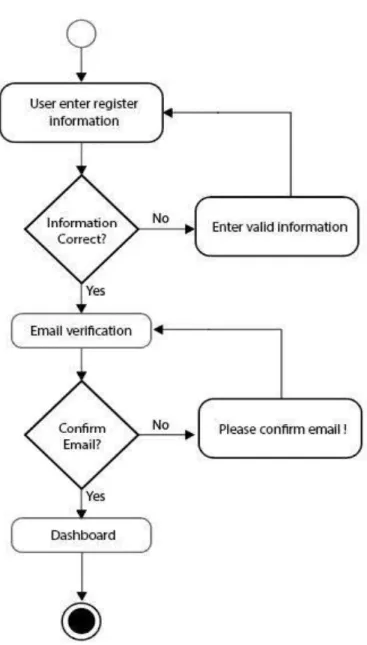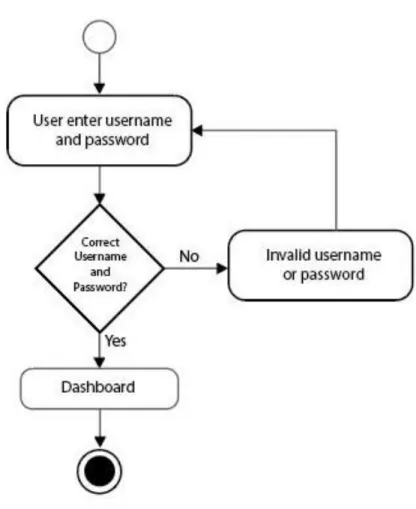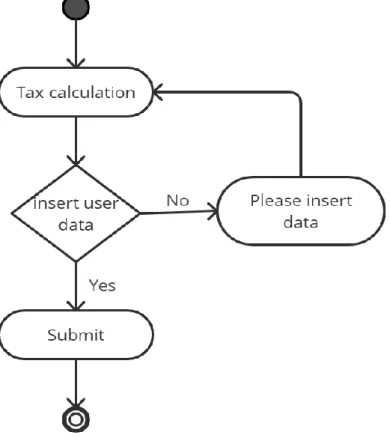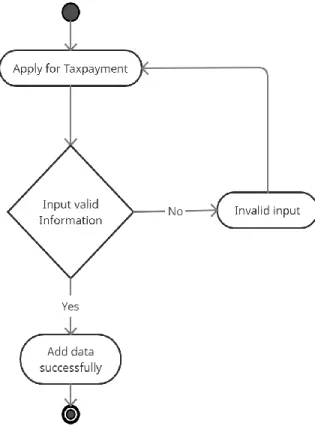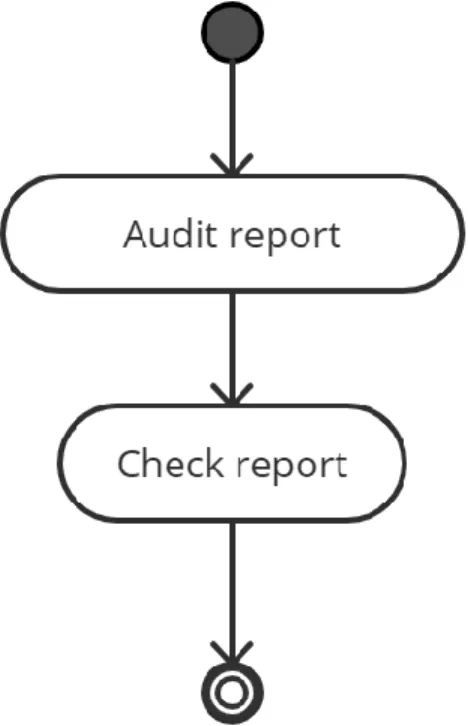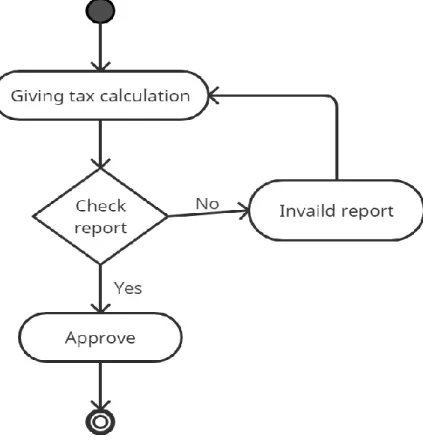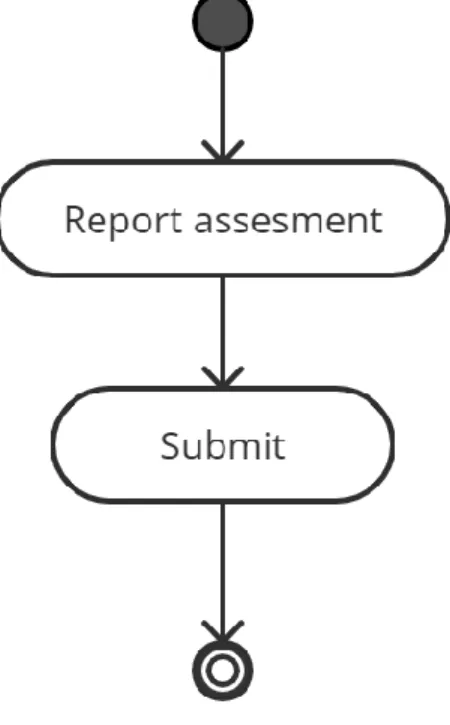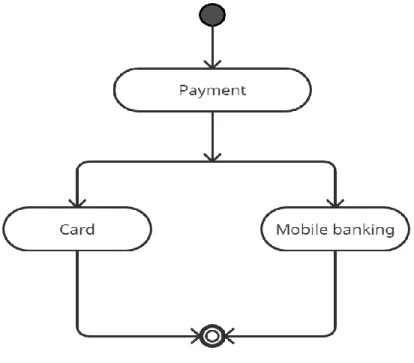Tax Payment System
Submitted by Md. Janip Ali Helal
ID: 171-35-2046
Department of Software Engineering Daffodil International University
Supervised by Kaushik Sarker
Assistant Professor & Associate Head Department of Software Engineering
Daffodil International University
This Project report has been submitted in fulfillment of the requirements for the Degree of Bachelor of Science in Software Engineering.
APPROVAL
This project titled on “Tax Payment System”, submitted by Sadman Fahim Arpan (ID: 171-35- 2046) to the Department of Software Engineering, Daffodil International University has been accepted as satisfactory for the partial fulfilment of the requirements for the degree of Bachelor of Science in Software Engineering and approval as to its style and contents.
DECLARATION
I hereby declare that project titled “Tax Payment System” has been completed by me under the supervision of Kaushik Sarker, Assistant Professor & Associate Head, Department of Software Engineering, Daffodil International University for the purpose of achieving degree of Bachelor of Science from Daffodil International University. This is also declared by me that neither this project nor any part of this project has been used or submitted elsewhere for any kind of degree or awards.
………
Md. Janip Ali Helal ID: 171-35-2046
Department of Software Engineering Daffodil International University
………
Kaushik Sarker Supervisor
Assistant Professor & Associate Head Department of Software Engineering Daffodil International University
ACKNOWLEDGMENT
First and foremost, all the praise and thanks go to the Almighty Allah for all the blessings for all my project work, giving me patience and enabling me to complete this project on time.
I would like to express my special thanks to my respected supervisor Kaushik Sarker for giving me his proper direction and for helping me to finish all the work in the end. I am especially grateful to my supervisor for his assistance throughout the project. His excellent guidance, advice, valuable constructive advice, has made it possible for me to complete this project with confidence.
I am very blessed to have the opportunity to study at Daffodil International University. I would like to express my deep gratitude to our honorable department Head of Department, SWE, for encouraging me and giving me such an opportunity. I want to thank all my respected teachers who teach us in a great, interesting and understandable way. I am grateful to them for making my journey the easiest and most enjoyable.
I am grateful to my parents as well as all the members of the family. My whole study journey would not have been so easy without their endless support and co-operation.
I am grateful to all my department staff members, lab technicians and non-teaching staff members for their ultimate support throughout my journey.
Finally, I would like to express my love to my batch mates, to the DIU members for their kind co- operation and comfort that helped me finish all the work.
ABSTRACT
The essential goal of our project is to compile a client's tax summary or tax returns. After successfully submitting all of the paperwork, a client registers himself with the Tax Information System, enters all of his information, and uploads different documents that are required for the preparation of Tax Summary and Schedules for an interview. When all of the processes have been done, the admin prepares Tax Returns or Tax Overviews for all of the clients. The admin contacts the clients and arranges an appointment to address different topics related to the Tax Overviews.
If the customer has paid the fee for the preparation of his Tax Summary, he will download his Tax Summary in PDF format.
Table of Contents
APPROVAL i
BOARD OF EXAMINERS Error! Bookmark not defined.
DECLARATION ii
ACKNOWLEDGMENT iii
ABSTRACT iv
LIST OF TABLES x
LIST OF FIGURES x
CHAPTER 1 1
INTRODUCTION 1
1.1 Project Overview 1
1.2 Project Purpose 1
1.2.1 Tax Calculation 2
1.2.2 Benefits & Beneficiaries 2
1.2.3 Goals 2
1.3 Stakeholders 3
1.4 Project Schedule 3
1.4.1 Gantt Chart 4
1.4.2 Project Timeline 5
CHAPTER 2 6
SOFTWARE REQUIREMENT SPECIFICATION 6
Functional requirement: Tax Payer 6
Functional requirement: Circle Officer: 6
Functional requirement: Area Officer: 7
2.3 Performance Requirements 7
2.3.1 Capacity Requirements 7
2.4 Dependability Requirements 8
2.4.1 Reliability Requirements 8
2.4.2 Fault-Tolerance Requirements 8
2.4.3 Safety-Critical Requirements 8
2.5 Maintainability and Supportability Requirements 8
2.5.1 Maintenance Requirements 8
2.5.2 Supportability Requirements 9
2.5.3 Adaptability Requirements 9
2.6 Security Requirements 9
2.6.1 Access Requirements 9
2.6.2 Integrity Requirements 9
2.6.3 Privacy Requirements 9
2.7 Usability and Human-Interaction Requirements 10
2.7.1. Ease of Use Requirements 10
2.7.2 Understandability Requirements 10
2.7.3 Accessibility Requirements 10
2.7.4 User Documentation Requirements 10
2.7.5 Training Requirements 10
CHAPTER 3 11
SYSTEM ANALYSIS & DESIGN 11
3.1 Use Case Diagram 11
3.2 Use Case Description 12
3.2.1 User Description 12
3.2.3 Area Officer Description 14
3.3 Activity Diagram 15
3.3.1 User Registration Activity 15
3.3.2 User login Activity 16
3.3.3 User Tax Calculation Activity 17
3.3.4 Taxpayer Apply for payment Activity 18
3.3.5 Audit report Activity 19
3.3.6 Giving tax calculation Activity 20
3.3.7 Report Assessment Activity 21
3.3.8 Payment Activity 22
3.3.9 Feedback Activity 23
3.4 System Sequence Diagram 24
3.4.1 User login 24
3.4.2 User register 25
3.4.3 User (tax payer) 26
3.4.4 Circle officer 27
3.4.5 Area Officer 28
3.5 System Entity Relation Diagram 29
3.7 Design and Implementation Constraints 30
3.7.1 Framework or Software Language: 30
3.8 Development Tools and Technology: 30
3.9 Project Organization 30
3.9.1 Software Process Model 30
CHAPTER 4 32
SYSTEM TESTING 32
4.1 Testing Features 32
4.1.1 Features to be tested 32
4.2 Testing Strategies 32
4.2.1 Test Approach 32
4.2.2 Test Category 32
4.2.3 Success/Failed Criteria 32
4.3 Testing Environment 33
4.4 Test Cases 34
Testing Case No-1 (Integration Testing) 34
Testing Case No-2 (Module Testing) 35
CHAPTER 5 36
USER MANUAL 36
5.1 Starting Page 36
5.2 Taxpayer login 36
5.3 Taxpayer Register 37
5.4 Taxpayer Dashboard 37
5.5 Tax Calculation 38
5.6 Taxpayment Assessment Submission Form 38
5.7 Personal Details 39
5.8 Taxpayer Profile 39
5.9 Change Password Page 40
5.10 Contact us 40
5.11 SSL Commerz 41
5.12 Invoice 41
5.14 Circle Officer Dashboard 42
5.15 Assessment List 43
5.16 Admin Login 43
5.17 Admin Dashboard 44
5.18 Admin Data table 44
5.19 Admin Assessment List 45
5.20 Payment List 45
CHAPTER 6 46
PROJECT SUMMARY 46
6.1 GitHub Link 46
6.2 Limitations 46
6.3 Obstacles and Achievements 46
6.4 Future Scope 46
6.5 References 47
6.6 Plagiarism Report 48
LIST OF TABLES CHAPTER 1
Table 1.4.2: Project Timeline………...5
CHAPTER 4 Table 4.4.1: Testing Case (User & Officer’s Login) ………...34
Table 4.4.2: Testing Case (Tax calculation)……….35
LIST OF FIGURES CHAPTER 1 Figure 1.4.1: Gantt chart……….4
CHAPTER 3 Figure 3.1: Use case for tax payment system ………11
Figure 3.3.1: User Registration Activity Diagram……….…….15
Figure 3.3.2: User login Activity Diagram………16
Figure 3.3.3: User Tax Calculation Activity Diagram………17
Figure 3.3.4: User Apply for Tax payment Activity Diagram……….18
Figure 3.3.5: Audit report Activity Diagram
………...……...….
19Figure 3.3.6: Giving Tax calculation Activity Diagram……….20
Figure 3.3.7: Report Assessment Activity Diagram
………..…
21Figure 3.3.8: Payment Activity Diagram
………...
22Figure 3.3.9: Feedback Activity Diagram………...…23
Figure 3.4.1: User login Sequence Diagram………..…….…24
Figure 3.4.2: User register Sequence Diagram……….………...25
Figure 3.4.3: Tax Payer Sequence Diagram……….26
Figure 3.4.5: Area Officer Sequence Diagram………28
Figure 3.5: Entity Relation Diagram………29
Figure3.9.1: Waterfall Model ………..31
CHAPTER 5 Figure 5.1 UI (User starting page)………36
Figure 5.2 UI (Taxpayer login page)………36
Figure 5.3 UI (Taxpayer Dashboard)……….……37
Figure 5.4 UI (Tax Calculation)………37
Figure 5.5 UI (Taxpayment Form)……….38
Figure 5.6 UI (Assessment report)……….38
Figure 5.7 UI (Tax payer Details)……….. 39
Figure 5.8 UI ()
………...
39CHAPTER 1 INTRODUCTION 1.1 Project Overview
In recent years, several developed countries have implemented tax reforms. Local conditions as well as the accelerated internationalization of economic practices prompted such changes. Local considerations hastening tax changes included the need to address fiscal imbalances and the transition from a centralized strategy to a market economy. Due to the difficulty of reducing spending, tax reform has been an important part of the fiscal stabilization plan. The move from strategy to market necessitated the replacement of administered rates with market-determined prices, the replacement of physical controls with financial controls, and the replacement of physical controls with financial controls and the replacement of public-sector gains with tax revenues.
In a globalizing climate, tax changes are also essential. To improve competition and encourage international investment, the tax system's performance and enforcement costs must be reduced.
Globalization also results in a lack of customs revenue, which must be offset with domestic revenues. In reaction to changes in growth policy, Bangladesh's tax system had to be reformed as well. Bangladesh's taxation system is well-developed. Bangladesh's tax system is mostly a two- tier system focusing on the central government and local government organizations. Local councils and counties are the most common examples of these local authorities.
1.2 Project Purpose
The purpose of this document is to describe all the requirements for the targeted Tax payment Govt. of Bangladesh. The intended audience includes all the Citizen of Bangladesh in the potential system. These include, but are not necessarily limited to, the following: Government Employee, Tax officer, Circle, Officer, Tax payer.
Developers should consult this document and its revisions as the only source of requirements for the project. They should not consider any requirements statements, written or verbal as valid until they appear in this document or its revision.
The Government Employee, Tax officer, Circle, Officer, Tax payer should use this document and its revisions as the primary means to communicate confirmed requirements to the development team. The development team expects many face-to-face conversations that will undoubtedly be about requirements and ideas for requirements. Please note that only the requirements that appear in this document or a future revision, however, will be used to define the scope of the system.
1.2.1 Tax Calculation
In this system, we can calculate all types of taxes. In our country people of different professions make a living through different means such as agriculture, government jobs, private jobs, owners of different institutions, teachers and many other people living in our country and earn money in different ways If a person earns 500,000 takas from agriculture, his tax amount will be 25,000 takas. If there are children with disabilities in the family, the number of taxes decreases and the number of taxes increases based on the value of the property deposited. Different districts and Upazilas are different for each region of the union.
1.2.2 Benefits & Beneficiaries
We have beneficial aspects of this solution. They are pointed out below:
• Ensure better revenue distribution,
• Efficient collection of revenue,
• User-friendly service,
• Higher rate of collection,
• Standard solutions for all tax types in whole tax system,
• Integrated solution for all revenue types,
• Significant decrease of costs and faster tax collection.
1.2.3 Goals
• Make the project in Live server
• People Will use it for his/her next tax payment
• Build National awareness to Make our Country More Developed.
• Tax calculations and payments are easy for people of all professions.
1.3 Stakeholders
There are three types of Stakeholders in our Solutions. They are:
• Area Officer
In the TPS the major and sensitive role is played by the Area Officer, in TPS this role is played by the Main character. The Area officer will check and validate all the process of Tax payment. Audit Circle officer work and tax payer details report.
• Circle Officer
In the TPS the secondary important role plays by circle officer, He can check the report of tax payer and audit tax payer properties information.
• Tax Payer
The role of a tax payer is also a most important role because, it’s the main primary actor of our system. A taxy payer can register in the system and input validated information for calculate how much max he/she have to pay. And see his/her report, and track his/her tax payment process in
home. He /She can payment the tax using online mobile banking system or credit card.
1.4 Project Schedule
Project Schedule is important for every project to complete on time.
1.4.1 Gantt Chart
It is a graphic view of overtime-planned tasks. It's a very efficient way to show on a particular day what work is planned to be completed. It also helps to demonstrate the start and finish times of my project.
Activities W
1 W 2
W 3
W 4
W 5
W 6
W 7
W 8
W 9
W 1 0
W 1 1
W 1 2
W 13
W 14
W 1 5
Planning Ideas Problem definition Proposal planning Requirement
s
Requirement Specification Requirement analysis QA -1 Quality
assurance System
Design
Design specification Interface design Database design Development Development
system modules Integrate system modules
QA -2 Test Cases Testing Unit testing
Black box testing Resolve
Issues
Resolve issues found
Release Software release
Figure 1.4.1: Gantt chart
1.4.2 Project Timeline
The Project timeline record is given below:
Task Date
Topic Selection Seminar 20/10/2020 Brainstorming
Project Topic & Name Selection
21/10/2020 – 27/10/2020
Submit Project Proposal 28/10/2020
Requirement Specification 29/10/2020 – 10/01/2021
Mid Term Defense 25/02/2021
System Analysis & Design 27/02/2021 – 25/03/2021 Development System 27/03/2021 – 18/05/2021 System Testing 21/05/2021 – 25/05/2021 Complete Project 26/05/2021
Table 1.4.2: Project Timeline
CHAPTER 2
SOFTWARE REQUIREMENT SPECIFICATION Functional requirement: Tax Payer
Requirement ID FR.TP.1 Requirement Name Log in
Description Tax Payer can log in using user name and password
Requirement ID FR.TP.2 Requirement Name Calculate Tax
Description Customer can Calculate Tax
Requirement ID FR.TP.3
Requirement Name Select Assessment From
Description Customer can Submit Tax Information in Assessment From
Requirement ID FR.TP.4 Requirement Name Tax Payment
Description Customer can Pay Tax
Requirement ID FR.TX.5 Requirement Name Select Report
Description Customer can See Details about his Tax
Functional requirement: Circle Officer:
Requirement ID FR.CO.1 Requirement Name Log in
Description Circle Officer can log in using user name and password
Requirement ID FR.CO.2
Requirement Name See Tax Payer Submission
Description Circle Officer can see all Tax Payer Submission
Requirement ID FR.CO.3
Requirement Name Submit Report for Tax Payer Description Circle Officer can Submit Report
Functional requirement: Area Officer:
Requirement ID FR.AO.1 Requirement Name Log in
Description Area Officer can log in using user name and password
Requirement ID FR.AO.2
Requirement Name Assessment Tax Payer Return
Description Area Officer can Assessment all Tax Payer
Requirement ID FR.AO.3
Requirement Name Action for Tax Payer
Description Area Officer can Action for Tax Payer
2.3 Performance Requirements
Reliability, safety, security, and availability are all part of the dependability criterion, but reliability is the most important. These requirements are also required.
2.3.1 Capacity Requirements
Both forms of user data must be handled by the device.
CR-1 System will handle many data
Description The system must be able to accommodate a wide range of data types.
Stakeholder Area Officer
2.4 Dependability Requirements
Four dimensions are used to assess dependability. Availability, Reliability, Safety, and Security are only a few examples. As a result, our device must meet these four dimensions.
2.4.1 Reliability Requirements
The likelihood that the machine will run without loss is referred to as reliability.
RR-1 System must be available 24/7
Description The system must be available at all times, updated, and free of malware.
Stakeholder N/A
2.4.2 Fault-Tolerance Requirements
It is critical to ensure 0% crush and correct performance for consumers in order to ensure fault- tolerance.
FTR-1 Without a single device bug, the system manages all user data.
Description Both users will use our system at the same time, and the system must manage requests without errors.
Stakeholder N/A
2.4.3 Safety-Critical Requirements
In my project, there are no safety-critical requirements.
2.5 Maintainability and Supportability Requirements
It is important to provide after-sales assistance or service to end customers.
2.5.1 Maintenance Requirements
MR-1 System helps to manage tax payer
Description It is very important.
Stakeholder Area Officer
2.5.2 Supportability Requirements
There is some dimension of supportability requirements. They are:
● Maintainability
● Configurability
● Compatibility
● Serviceability
2.5.3 Adaptability Requirements
There are no adaptability requirements of my project.
2.6 Security Requirements
The importance of security specifications for device solutions cannot be overstated. It should be based on practical needs. Software Protection is concerned with the application system's security.
There are some specifications in terms of protection. They are:
● Sign in an area officer, circle officer or tax payer.
● Get access according to logged in user.
● Sign out as an area officer, circle officer or tax payer.
2.6.1 Access Requirements
In my project, there is no prerequisite for entry.
2.6.2 Integrity Requirements
In my project, there is no provision for authenticity.
2.6.3 Privacy Requirements
In any scheme, it is important to have privacy standards. Any consumer can join the system by checking their details and using their accessibility settings to ensure privacy.
2.7 Usability and Human-Interaction Requirements
The primary goal of any device solution is to make it user-friendly and simple to use.
2.7.1. Ease of Use Requirements
Our Solution is easy to use and understandable
EUR-1 System must be usable & easy for the user Description This solution is easy for user to manage system Stakeholder Area Officer, Circle Officer and Tax Payer
2.7.2 Understandability Requirements
In my project, there are no well-defined criteria.
2.7.3 Accessibility Requirements
In my project, there are no clear usability criteria.
2.7.4 User Documentation Requirements
In my project, there are no conditions for user documentation.
2.7.5 Training Requirements
In my project, there are no training specifications.
CHAPTER 3
SYSTEM ANALYSIS & DESIGN 3.1 Use Case Diagram
There are two actors in our use case diagram. This diagram will refine my project in details
Figure 3.1: Use case for tax payment system
3.2 Use Case Description 3.2.1 User Description
Name of Use Case: Tax Payer
Description: Tax Payer Input Information, Submit Return, Calculate Tax, Tax Payment
Actors: Tax Payer
Preconditions: 1. Tax Payer must be Registered 2. Must be Submitted Information 3. Must be Calculate Tax
Postconditions: 1. Tax Payer must use Payment gateway option 2. See Report
Flow: 1. Tax Payer Registration Account for Payment 2. Select Tax Return Information
3. Input All Information 4. Calculate Tax Charge 5. Tax Charge Payment 6. View Feedback /Report
Alternative Flows: 5. In step 5 of the normal flow, if the tax payer Payment by Credit Card or Mobile Banking.
Exceptions:
Requirements: The following requirements must be met before execution of the use case
1. Tax Payer Must be Registered
2. Must Be Input Details Tax Return Information
3.2.2 Circle Officer Description Name of Use Case: Circle Officer
Description: Circle Officer Assessment Tax Payer Information and Submit Report
Actors: Circle Officers
Preconditions: 1. Officer Must be Registered Postconditions:
Flow: 1. Circle Officer Login their Portal 2. See Tax Payer Details
3. Assessment Tax Payer Return Document 4. Create Reports
Alternative Flows:
Exceptions:
Requirements: The following requirements must be met before execution of the use case
1. Must Be Registered
3.2.3 Area Officer Description
Name of Use Case: Area Officer
Description: Area Officer See Assessment Report, See Payment, See Details and Action against Tax Payer
Actors: Area Officers
Preconditions: 1. Officer Must be Registered Postconditions:
Flow: 1. Area Officer Login their Portal 2. See Tax Payer Details
3. See Assessment Reports 4. Take Action
Alternative Flows:
Exceptions:
Requirements: The following requirements must be met before execution of the use case
1. Must Be Registered
3.3 Activity Diagram
3.3.1 User Registration Activity
Users can register with their correct information then will have to verify the email verification.
Figure 3.3.1: User Registration Activity Diagram
3.3.2 User login Activity
Users can login with their email and password
Figure 3.3.2: User login Activity Diagram
3.3.3 User Tax Calculation Activity
This method will be used to calculate the amount of tax to be paid to the user.
Figure 3.3.3: User Tax Calculation Activity Diagram
3.3.4 Taxpayer Apply for payment Activity
The taxpayer has to give the correct information for tax payment.
Figure 3.3.4: User Apply for Tax payment Activity Diagram
3.3.5 Audit report Activity
Admin can check report.
Figure 3.3.5: Audit report Activity Diagram
3.3.6 Giving tax calculation Activity
Figure 3.3.6: Giving Tax calculation Activity Diagram
3.3.7 Report Assessment Activity
This method will check whether the taxpayer is paying the tax at the right time.
Figure 3.3.7: Report Assessment Activity Diagram
3.3.8 Payment Activity
Users can make payments through mobile banking or card.
Figure 3.3.8: Payment Activity Diagram
3.3.9 Feedback Activity
The user will give feedback with this method.
Figure 3.3.9: Feedback Activity Diagram
3.4 System Sequence Diagram 3.4.1 User login
Figure 3.4.1: User login Sequence Diagram
3.4.2 User register
Figure 3.4.2: User register Sequence Diagram
3.4.3 User (tax payer)
Figure 3.4.3: Tax Payer Sequence Diagram
3.4.4 Circle officer
Figure 3.4.4: Circle Officer Sequence Diagram
3.4.5 Area Officer
Figure 3.4.5: Area Officer Sequence Diagram
3.5 System Entity Relation Diagram
Figure 3.5: Entity Relation Diagram
3.7 Design and Implementation Constraints 3.7.1 Framework or Software Language:
The user interface for “Tax Payment System” is created using the Laravel system and a bootstrap prototype, with data stored in a MySQL database.
3.8 Development Tools and Technology:
▪ IDE: Sublime Text
▪ Database: MySQL
▪ UI: HTML, CSS, Bootstrap, JavaScript
▪ Framework: Laravel 6
▪ Language: PHP
▪ Web-Server: XAMPP Server
3.9 Project Organization 3.9.1 Software Process Model
The Waterfall Model was the first Process Model to be applied. In a Waterfall model, each step must be finished before the next phase can begin, and there is no overlap between the phases. The waterfall model was the first SDLC technique used in software creation. In "The Waterfall"
approach, the entire software production process is broken down into phases. The output of one stage is used as the starting point for the next move. This implies that each stage of the creation process begins only if the previous stage has been completed. The waterfall model is a sequential modeling mechanism in which creation is seen as continually streaming downward through the phases of conception, initiation, analysis, design, construction, testing, production/implementation, and maintenance (like a waterfall).
The Waterfall Model is also known as a model of the linear sequential life cycle because it represents the process of software development in a linear sequential flood.
Figure3.9.1: Waterfall Model
CHAPTER 4 SYSTEM TESTING 4.1 Testing Features
Testing is described as an operation that verifies that the actual results match the expected results and ensures that the system is defect-free. Testing functions can be seen as a way to bring more flexibility to a current project or modify it.
4.1.1 Features to be tested
There are some features below:
➢ Login
➢ Tax Calculation
4.2 Testing Strategies
Each part of the program is handled differently by test methods. It's a collection of detailed guidelines for the test's existence and each stage of the scenario. It outlines which methodology to be used and which modules should be reviewed.
4.2.1 Test Approach
Checking is one of the most important aspects of any software project. It demonstrates the utility of apps. It also aids in the detection of program flaws and defects. As a result, the user perceives the software to be simple and error-free. Without using any automated tools, I manually evaluated and validated each work.
4.2.2 Test Category
▪ Integration Testing
▪ Module Testing
4.2.3 Success/Failed Criteria
The pass/fail test criteria will be decided by the test engineers. It all boils down to how well all of the requirements work together. When the test results are satisfactory, a pass or a failure will be determined. In any case, I'm certain that I'll graduate with flying colors. It would be considered an error if a function does not perform properly during the test.
4.3 Testing Environment
There are some key areas to set up for testing
➢ Operating System
➢ Browser
➢ System
➢ Application
➢ Database server
➢ Test data
➢ Network
4.4 Test Cases
Testing Case No-1 (Integration Testing)
Test Case ID.1 Module name: User, Circle Officer & Area Officer Test Priority: High Test Date:18.05.2021
Test Title: User & Officer’s Login Verification with valid email &
password
Test executed by: Md. Janap Ali Helal
Description: Test User’s & Officer’s Login Page
Test executed date: 18.05.2021
Pre-condition: Users must have valid email and password.
Test steps: 1. Go to login page
2. Provide valid email & password 3. Click Sign in button
Test Data: User’s: Email: [email protected]
Password: test
Officer’s: Email: [email protected] Password: 123456
Expected Results: User should able to login Actual Result: User logged in successfully
Status (Pass/Fail): Pass
Post-condition: Successfully Logged in.
Table 4.4.1: Testing Case (User & Officer’s Login)
Testing Case No-2 (Module Testing)
Test Case ID.2 Module name: Tax calculation
Test Priority: High Test Date:18.5.2021
Test Title: Add teacher with validation Test executed by: Md. Janip Ali Helal Description: Tax Calculation Test executed date: 18.05.2021
Pre-condition: User must login and insert valid data
Test steps: 1. After login go to Tax calculation
2. Click tax calculation 3. Insert data all the field 4. Click Submit button Test Data:
Expected Results: User add Successfully
Actual Result: User add Successfully
Status (Pass/Fail): Pass
Table 4.4.2: Testing Case (Add Teacher)
CHAPTER 5 USER MANUAL 5.1 Starting Page
Figure 5.1 UI (User starting page)
5.2 Taxpayer login
The admin will login with their email and password on this tab.
5.3 Taxpayer Register
Figure 5.3 UI (Taxpayer Register page)
5.4 Taxpayer Dashboard
Users can view all aspects of the menu & dashboard with data.
Figure 5.4 UI (Taxpayer Dashboard)
5.5 Tax Calculation
Figure 5.5 UI (Tax Calculation)
5.6 Taxpayment Assessment Submission Form
Figure 5.6 UI (Taxpayment Form)
5.7 Personal Details
Figure 5.7 UI (Personal details)
5.8 Taxpayer Profile
Figure 5.8 UI (Taxpayer Profile)
5.9 Change Password Page
Figure 5.9 UI (Tax payer Change Password)
5.10 Contact us
Figure 5.10 (Contact Us)
5.11 SSL Commerz
Figure 5.11 (SSL Commerz)
5.12 Invoice
Figure 5.12 (Invoice)
5.13 Circle Officer Login
Figure 5.13 (Circle Officer login)
5.14 Circle Officer Dashboard
Figure 5.14 (Circle Officer Dashboard)
5.15 Assessment List
Figure 5.15 (Assessment List)
5.16 Admin Login
Figure 5.16 (Admin Login)
5.17 Admin Dashboard
Figure 5.17 (Admin Dashboard)
5.18 Admin Data table
Figure 5.18 (Admin Data table)
5.19 Admin Assessment List
Figure 5.19 (Admin Assessment List)
5.20 Payment List
Figure 5.20 (Payment List)
CHAPTER 6 PROJECT SUMMARY 6.1 GitHub Link
https://github.com/
6.2 Limitations
I ran into several roadblocks in the way. I'm still studying the required technologies, but I haven't been able to overcome these obstacles yet. But I'm optimistic that given enough time, I'll be able to study advanced topics and improve the code significantly.
Mobile version: The user would choose it on their mobile device because it is a travel-related app.
I was unable to create a mobile version of the program due to my lack of experience with mobile devices and a lack of time.
6.3 Obstacles and Achievements
From the beginning of the process, I've gained much too much useful information for developers.
To begin with, I have no idea how to properly create a design, such as how to write algorithms and diagrams for project work such as database design. Before now, I had no idea what the algorithm meant or how much of it a programmer needs to construct a project. Many key aspects of the language I used to develop this structure are critical. Before starting the logical section, I check to see if the database architecture and project UI are complete; if they are, then executing the code would be a breeze. In a summary, creating this software was a major milestone for me.
6.4 Future Scope
The software being developed is the software of good quality. I'm doing my hardest to fulfill the true need for the stage of the procedure. But still, there is space to expand more. I have introduced the program and do my hardest to produce an exceptional system.
6.5 References
[1] "creately," creately, 2008-2021. [Online]. Available: https://creately.com/. [Accessed 2021].
[2] J. resig., "Jquery.," 2006. [Online]. Available: http://jquery.com/. [Accessed 12 09 2020].
[3] K. Sun, "Lucidchart," 2008. [Online]. Available: www.lucidchart.com/pages/. [Accessed 10 10 2020].
[4] G. Alder, "draw.io," draw, [Online]. Available: https://app.diagrams.net/. [Accessed 2021].
[5] Microsoft, "Microsoft word 2019," [Online]. [Accessed 2021].
[6] Microsoft, "Microsoft Powerpoint 2019," [Online]. [Accessed 2021].
[7] S. M. V. Lardent, "Time New Roman," Monotype, 1932. [Online]. [Accessed 2021].
[8] I. o. R. E. American Institute of Electrical Engineers, IEEE Standards Association, 1963. [Online].
Available: https://www.ieee.org/. [Accessed 2021].
